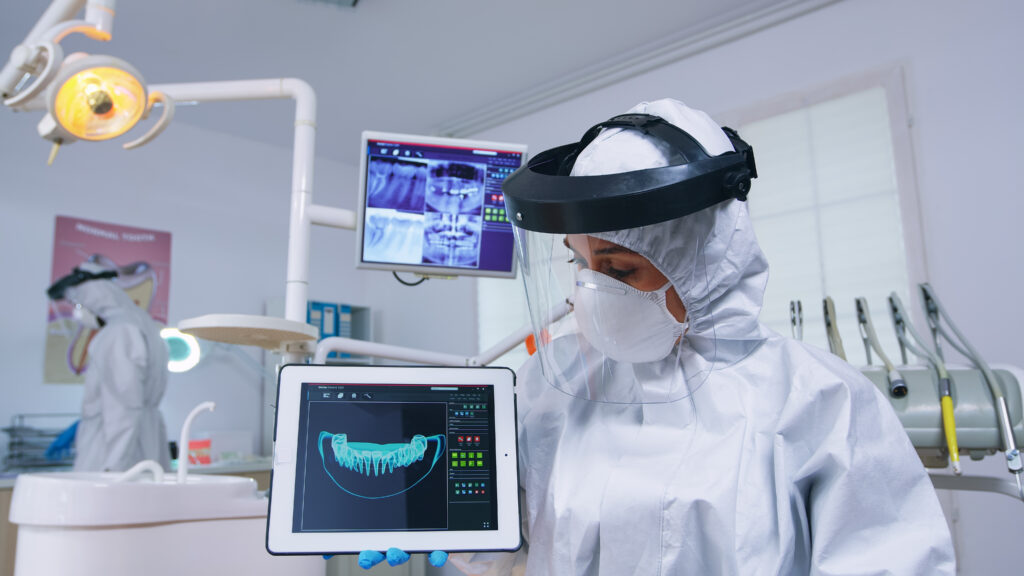The dental industry is undergoing a major transformation, thanks to rapid advancement in technology. As we move through 2025, new innovations are reshaping how dental care is delivered—making treatments faster, more precise, and more comfortable than ever before. Whether you’re a dental professional or curious patient, here are the top dental technology trends to keep an eye on this year.
- AI-Powered Diagnostics and Treatment Planning
– Artificial Intelligence (AI) is revolutionizing diagnostics in dentistry. In 2025, AI systems are being integrated into dental practices to help detect issues like cavities, bone loss, and even oral cancers with exceptional accuracy. These tools analyze X-rays and intraoral scans in real time, providing dentists with a second opinion that improves treatment planning and outcomes
✅ Example: Tools like Pearl and Overjet use AI to highlight problem areas on radiographs, helping clinicians catch early-stage issues that may be missed by the human eye. - 3D Printing for the Same-Day Restorations
– 3D printing technology is advancing rapidly, and 2025 marks a significant leap. Dentists can now fabricate crowns, bridges, dentures , and even aligners in-house—often within a single appointment. This not only speeds up the treatment process but also reduces lab costs and improves patient satisfaction.
✅ Innovation spotlight: Biocompatible materials are now stronger and more aesthetically pleasing, making 3D-printed prosthetics a reliable long-term solution. - Smart Toothbrushes with Real-Time Feedback
– Oral hygiene has gone high-tech. Smart toothbrushes are evolving into mini oral health assistants, using sensors and Bluetooth connectivity to guide brushing habits. In 2025, these devices now come with AI-driven apps that offer personalized recommendations based on brushing data.
✅ Popular features: Pressure sensors, coverage tracking, and reminders for flossing or replacing your brush head. - Teledentistry 2.0: Beyond Virtual Consults
– While teledentistry gained traction during the pandemic, its capabilities in 2025 have expanded dramatically. Today’s virtual platforms support remote monitoring, AI-assisted diagnosis, and even at-home impression kits that sync with digital software.
✅ Impact: Increased accessibility for patients in rural or underserved areas, and a smoother pre-visit experience for everyone. - Laser Dentistry for Minimally Invasive Care
– Laser technology continues to evolve, offering patients more comfortable and precise treatments. In 2025, new generation lasers are being used for cavity preparation, gum reshaping, teeth whitening, and even periodontal therapy—with minimal discomfort and faster healing.
✅ Benefits: Reduced need for anesthesia, less bleeding, and quicker recovery times. - Augmented Reality (AR) in Dental Training and Procedures
– AR is no longer just for gaming. Dental professionals are now using augmented reality for training, treatment planning, and even during live procedures. AR glasses can project patient data, 3D models, and step-by-step guides directly into the dentist’s field of view.
✅ Example: Students and clinicians alike are benefiting from immersive simulations that improve skill development without risk. - Regenerative Dentistry and Bioprinting
– Perhaps the most futuristic development is regenerative dentistry, Researchers in 2025 are making strides in growing dental tissues like dentin, pulp, and even enamel using stem cells and bioprinting techniques. While still in early stages, this technology holds promise for natural tooth repair in the near future.
✅ Looking ahead: Instead of filling a cavity, your dentist may soon help your tooth regrow the missing structure naturally.
The Future of Dentistry Is Here
From AI diagnostics to regenerative procedures, the dental world is becoming smarter, faster and more patient-friendly. These trends don’t just promise better outcomes—they signal a shift toward more personalized, proactive care. If you’re due for a checkup or considering treatment, ask your dental provider how these innovations may benefit you.

